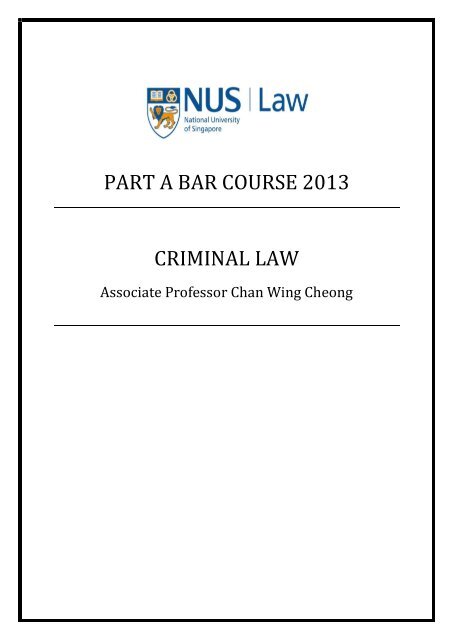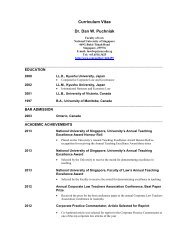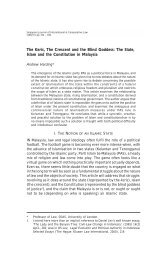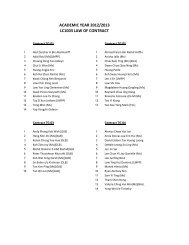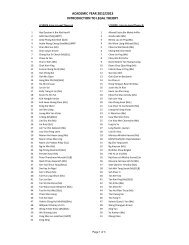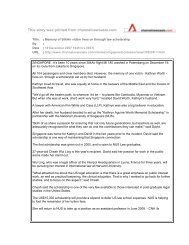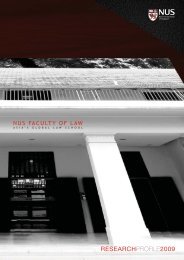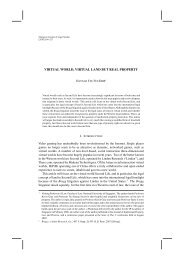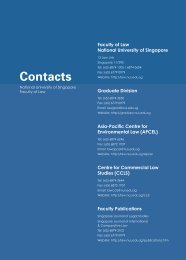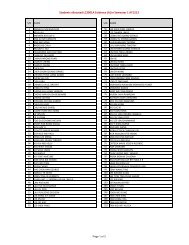PART A BAR COURSE 2013 CRIMINAL LAW
PART A BAR COURSE 2013 CRIMINAL LAW
PART A BAR COURSE 2013 CRIMINAL LAW
- No tags were found...
You also want an ePaper? Increase the reach of your titles
YUMPU automatically turns print PDFs into web optimized ePapers that Google loves.
<strong>PART</strong> A <strong>BAR</strong> <strong>COURSE</strong> <strong>2013</strong> <strong>CRIMINAL</strong> <strong>LAW</strong>SYLLABUS10. In your own opinion, what are the greatest challenges facing the Singaporecriminal justice system today?2
<strong>PART</strong> A <strong>BAR</strong> <strong>COURSE</strong> <strong>2013</strong> <strong>CRIMINAL</strong> <strong>LAW</strong>SYLLABUSTopic 2: The Penal CodeAims1. Advantages and disadvantages of codification of the criminal law2. The proper approach to interpreting provisions of the Penal CodeMaterials1. YMC 2nd Ed, chaps 1 and 38.2. PP v Kwan Kwong Weng [1997] 1 SLR(R) 316 [note: this part of the Penal Codehas since been amended by the Penal Code (Amendment) Act 2007]3. Interpretation Act, s 7AStudy questions1. What does it mean to have a codified system of law?2. Explain what are the advantages and disadvantages to a codified system ofcriminal law compared to the common law system.3. Draw up a list of case authorities in order of precedence, commencing withbinding, to highly persuasive, to persuasive.4. Have a quick look at the provisions of the Penal Code and identify someprovisions that need to be revised. Explain why there is a need to amend theseprovisions and how they should be amended.5. “It is high time that our Penal Code, a nineteenth century European innovation,be replaced by an entirely new Code which accurately reflects the thinking,values and notions of criminal justice of present day Singaporeans.” Discuss.3
<strong>PART</strong> A <strong>BAR</strong> <strong>COURSE</strong> <strong>2013</strong> <strong>CRIMINAL</strong> <strong>LAW</strong>SYLLABUSTopic 3: Homicide and the Fault RequirementsAims1. The principal fault elements of crimes: intention, knowledge, rashness,negligence2. The fault elements for homicide offencesMaterials1. Penal Code, ss. 299-304A2. Penal Code (Amendment) Act 20123. Road Traffic Act, s 664. YMC 2nd Ed, chaps 4, 8, 9, 105. State of Andhra Pradesh v Rayavarapu Punnayya AIR 1977 SC 45, YMC 2nd Edcasebook p. 976. Tham Kai Yau v PP [1977] 1 MLJ 174, YMC 2nd Ed casebook p. 1017. Tan Chee Wee v PP [2004] 1 SLR(R) 479, YMC 2nd Ed casebook p. 1048. Yeap Boon Hai v PP [2010] 2 MLJ 433, YMC 2nd Ed casebook p. 1079. PP v AFR [2011] 3 SLR 653, YMC 2nd Ed casebook p. 11010. Virsa Singh v State of Punjab AIR 1958 SC 465, YMC 2nd Ed casebook p. 12111. Ike Mohamed Yasin bin Hussin v PP [1974-1976] SLR(R) 596, YMC 2nd Edcasebook p. 12512. PP v Lim Poh Lye [2005] 4 SLR(R) 582, YMC 2nd Ed casebook p. 13613. Tan Cheng Eng v PP William [1968-1970] SLR(R) 761, YMC 2nd Ed casebook p.14114. Emperor v Dhirajia [1940] All 647, YMC 2nd Ed casebook p. 14315. PP v Teo Poh Leng [1991] 2 SLR(R) 541, YMC 2nd Ed casebook p. 14616. S Balakrishnan v PP [2005] 4 SLR(R) 249, YMC 2nd Ed casebook p. 15117. Lim Hong Eng v PP [2009] 3 SLR(R) 682, YMC 2nd Ed casebook p. 15418. Lim Poh Eng v PP [1999] 1 SLR(R) 428, YMC 2nd Ed casebook p. 15919. Seah Siak How v PP [1965] 1 MLJ 53, YMC 2nd Ed casebook p. 16520. Lim Chin Poh v PP [1968-1970] SLR(R) 483, YMC 2nd Ed casebook p. 16921. Ng Keng Yong v PP [2004] 4 SLR(R) 89, YMC 2nd Ed casebook p. 22Study questions1. What do you understand by the observation that “the fault elements of s 299,300 and 304A” of the Penal Code constitute a schematic approach towardscriminal responsibility”?2. Are the distinctions between the various clauses of ss 299 and 300 too fine?3. Describe the fault requirement for s. 300(c) Penal Code. Does this fit well withother provisions of s. 300?4. Have the problems in the interpretation of s. 300(c) Penal Code been solved bymaking the death penalty discretionary for this form of murder?5. According to the case law, what is the difference between a “rash” and a“negligent” act? Do you agree with the way this distinction is drawn?4
<strong>PART</strong> A <strong>BAR</strong> <strong>COURSE</strong> <strong>2013</strong> <strong>CRIMINAL</strong> <strong>LAW</strong>SYLLABUS6. Do you agree with the present approach of the Singapore courts towards theinterpretation of criminal negligence?7. English law has developed the concept of gross negligence as the basis forcriminal liability. Is this workable?8. What is the difference between “negligence”, “rash”, “reckless”, and“dangerous”?9. Does PP v Poh Teck Huat [2003] 2 SLR(R) 299 contradict itself where it was saidthat “criminal rashness and criminal negligence involve two different states ofmind”, but that “negligence does not end nicely where rashness begins and thereis a certain measure of overlap”?10. Explain the difference between “rashness” in s 304A and (i) knowledge that anact is so imminently dangerous that it must in all probably cause death (s 300(d);and (ii) knowledge that an act is likely to cause death (cl 3 of s 299).11. Consider the range of penalties in s 300(d) of the Penal Code, s 299 limb 3 of thePenal Code, s 304A of the Penal Code, and s 66 of the Road Traffic Act. Is thisjustified?5
<strong>PART</strong> A <strong>BAR</strong> <strong>COURSE</strong> <strong>2013</strong> <strong>CRIMINAL</strong> <strong>LAW</strong>SYLLABUSTopic 4: CausationAims1. The tests for causation under the Penal Code2. Comparison with the tests for causation under common lawMaterials1. Penal Code, s 299 Explanations 1 and 22. YMC 2nd Ed, chap 53. YMC 2nd Ed, chap 10 paras [10.11] – [10.14]4. Shaiful Edham bin Adam v PP [1999] 1 SLR(R) 442, YMC 2nd Ed casebook p. 47,para [86]5. R v Blaue [1975] 3 All ER 4466. Ng Keng Yong v PP [2004] 4 SLR(R) 89, YMC 2nd Ed casebook p. 25Study questions1. Critically evaluate YMC’s use of foreign case authorities to help clarify theprinciples of causation under the Indian Penal Code.2. State, giving reasons, whether or not you agree with YMC’s contention that theforesight test is superior to the substantial cause test to resolve issues ofintervening causes in the criminal law.3. How should Explanations 1 and 2 to s 299 of the Penal Code be understood?4. Should the test of causation in cases of culpable homicide/murder differ fromcases of causing death by a rash or negligent act?6
<strong>PART</strong> A <strong>BAR</strong> <strong>COURSE</strong> <strong>2013</strong> <strong>CRIMINAL</strong> <strong>LAW</strong>SYLLABUSTopic 5: Concurrence of Physical and Fault ElementsAim1. The requirement of concurrence and its exceptionsMaterials1. YMC 2nd Ed, chap 62. Muhammad Radi v PP [1994] 1 SLR(R) 406, YMC 2nd Ed casebook p. 443. Shaiful Edham bin Adam v PP [1999] 1 SLR(R) 442, YMC 2nd Ed casebook p. 474. R v Miller [1983] 2 AC 161, YMC 2nd Ed casebook p. 595. Wang Wenfeng v PP [2012] 4 SLR 590Study questions1. Evaluate the soundness of the Thabo Meli approach. Might the court havemanipulated legal principles to reach the desired result?2. Can the problem of concurrence be solved by making a distinction betweendeaths which are intended or known and deaths which are not intended orunknown? Consider s. 301 of the Penal Code.3. How might you persuade our courts to adopt the proposed moral congruenceapproach to problems of concurrence?4. Do you agree with YMC that concurrence could be made out even where therewas no preconceived plan, and so long as one of the prescribed fault elements ofthe offence in question was proven?7
<strong>PART</strong> A <strong>BAR</strong> <strong>COURSE</strong> <strong>2013</strong> <strong>CRIMINAL</strong> <strong>LAW</strong>SYLLABUSTopic 6: Strict LiabilityAims1. “Public welfare” offences vs individual blameworthiness2. Meaning of strict liability vs absolute liability3. Different judicial approaches: presumption of mens rea, due diligence and chapIV approaches4. Comparison of English common law vs Singaporean lawMaterials1. Penal Code, ss. 40(2), 52 and 792. YMC 2nd Ed, chap 73. PP v Teo Kwang Kiang [1991] 2 SLR(R) 560, YMC 2nd Ed casebook p. 704. MV Balakrishnan v PP [1998] SGHC 416, YMC 2nd Ed casebook p. 735. Tan Khee Wan Iris v PP [1995] 1 SLR(R) 723, YMC 2nd Ed casebook p. 776. Tan Cheng Kwee v PP [2002] 2 SLR(R) 1227. Lim Chin Aik v The Queen [1963] AC 1608. Comfort Management Pte Ltd v PP [2003] 2 SLR(R) 67Study questions1. What are the supposed justifications for having strict liability offences, and arethose justifications warranted?2. Judicial consideration of claims of mistake of fact in relation to strict liabilityoffences is a complicated one with several competing approaches devisedwithout the courts explaining how the ultimate choice was made. Might the lawbe better off if s 79 of the Penal Code were invariably applied to all such cases?Such a solution will mean that, unless there is explicit statutory provision, therewill no longer be offences of strict liability. Is this politically acceptable?3. Describe the different approaches that a Singapore court can take wheninterpreting a statute which does not make it clear whether proof of fault isrequired for conviction.4. What is the difference between a strict liability offence and an offence requiringproof of negligence?8
<strong>PART</strong> A <strong>BAR</strong> <strong>COURSE</strong> <strong>2013</strong> <strong>CRIMINAL</strong> <strong>LAW</strong>SYLLABUSTopic 7: Introduction to Criminal DefencesAims1. Distinction between denying an offence element and pleading a defence2. The burden and standard of proof3. General and special exceptions in the Penal CodeMaterials1. Evidence Act, ss. 103, 1072. Chapter IV, Penal Code3. Exceptions to s 300, Penal Code4. YMC 2nd Ed, chap 165. YMC 2nd Ed, chapter 2, paras [2.23] – [2.27]6. Jayasena v The Queen [1970] AC 618, YMC 2nd Ed casebook p. 272Study questions1. Who has the burden of proving a defence in Singapore law?2. Are there any convincing reasons why it is the prosecution who must prove thecommission of a crime, but the accused who must prove a general or specialexception under the Penal Code?3. Why are defences which ipso facto involve casting doubt on an element of acrime not exempt from the rule that it is the accused who must prove a defence?Take for example, the defence of mistake of fact under s 79 of the Penal Code.4. Might there be circumstances in which it would be desirable for a particularoffence to exclude the operation of the “general exception” under the PenalCode? Take, for example, the Internal Security Act which stipulates that thedefence of duress under s 94 of the Penal Code is inapplicable for the purposesof the offences under that legislation.9
<strong>PART</strong> A <strong>BAR</strong> <strong>COURSE</strong> <strong>2013</strong> <strong>CRIMINAL</strong> <strong>LAW</strong>SYLLABUSTopic 8: Unsoundness of MindAims1. Elements of the defence and the special consequences of a successful plea2. Comparison with the defence of insanity in English common lawMaterials1. Penal Code, s. 842. Criminal Procedure Code, ss. 251-253, 255, 3393. YMC 2nd Ed, chap 244. PP v Rozman bin Jusoh [1995] 2 SLR(R) 879, YMC 2nd Ed casebook p. 407Study questions1. Are juries more likely to believe the defence expert than judges? If so, why? (Trialby jury existed in Singapore until 1960s).2. Is the s. 84 Penal Code formulation better or worse than Macaulay’soriginal version which reads:“Nothing is an offence which a person does in consequence of beingmad or delirious at the time of doing it.”Specifically, if an accused had committed an alleged crime “in consequence of”unsoundness of mind, why does the accused have to show further that he or shesuffered from one of the incapacities specified in s. 84?3. What will happen to an accused on a successful plea of the defence ofunsoundness of mind?4. What constitutes “unsoundness of mind” in s. 84 of the Penal Code?5. What is the disjunctive or conjunctive view concerning the phrase “wrong orcontrary to law” in s. 84 of the Penal Code?10
<strong>PART</strong> A <strong>BAR</strong> <strong>COURSE</strong> <strong>2013</strong> <strong>CRIMINAL</strong> <strong>LAW</strong>SYLLABUSTopic 9: Diminished ResponsibilityAims1. Elements of the special exception2. Comparison with unsoundness of mindMaterials1. YMC 2nd Ed, chap 272. Penal Code, Exception 7 to s. 3003. G Krishnasamy Naidu v PP [2006] 4 SLR(R) 874, YMC 2nd Ed casebook p. 4424. Ong Pang Siew v PP [2011] 1 SLR 606, YMC 2nd Ed casebook p. 4485. PP v Tengku Jonaris Badlishah [1998] SGHC 401, YMC 2nd Ed casebook p. 454Study questions1. Explain the difference between unsoundness of mind and diminishedresponsibility as a defence in terms of:a. The mental condition of the accusedb. The cause of the mental conditionc. The severity of the mental conditiond. The offences for which the defence appliese. The effect of a successful defence2. Should diminished responsibility be a defence as well for other offences?3. To what extent is it practicable for a court to distinguish between:a. substantial and insubstantial impairment of mental responsibility?b. a situation where the accused “did not” as opposed to “could not” resisthis or her impulse?4. Are there sound reasons for:a. recognising irresistible impulse for diminished responsibility but not forunsoundness of mind?b. a successful plea of diminished responsibility to result in imprisonmentand of unsoundness of mind to result in indefinite detention?11
<strong>PART</strong> A <strong>BAR</strong> <strong>COURSE</strong> <strong>2013</strong> <strong>CRIMINAL</strong> <strong>LAW</strong>SYLLABUSTopic 10: IntoxicationAims1. Types of intoxication defences under the Penal Code2. Elements of the defences and consequences of a successful plea3. Comparison with defences of unsoundness of mind and diminished responsibilityMaterials1. YMC 2nd Ed, chap 252. Penal Code, ss. 85, 863. PP v Tan Ho Teck [1987] SLR(R) 88, YMC 2nd Ed casebook p. 4214. Juma’at bin Samad v PP [1993] 2 SLR(R) 327, YMC 2nd Ed casebook p. 4285. Tan Chor Jin v PP [2008] 4 SLR(R) 306, YMC 2nd Ed casebook p. 4306. Chan Kwee Fong v PP [2010] 1 MLJ 441, YMC 2nd Ed casebook p. 438Study questions1. When might intoxication be pleaded as a defence under the Penal Code?2. Why should involuntary intoxication under s. 85(2)(a) of the Penal Code dependon the “malicious or negligent act” of another? Is the discarded definition of“without his knowledge or against his will” more to the point?3. Does the formulation of involuntary intoxication under s. 85(2)(a) do justice tothe intuitive moral distinction between involuntary intoxication (more deservingof sympathy) and voluntary intoxication (less deserving of sympathy)?4. What is to be made of the recognition of voluntary intoxication under s. 86(2)?5. What is the difference between insane intoxication (s. 85(2)(b)) and unsoundnessof mind (s. 84)?12
<strong>PART</strong> A <strong>BAR</strong> <strong>COURSE</strong> <strong>2013</strong> <strong>CRIMINAL</strong> <strong>LAW</strong>SYLLABUSTopic 11: ProvocationAims1. Elements of the special exception2. Comparison with English lawMaterials1. Penal Code, Exception 1 to s. 3002. YMC 2nd Ed, chap 293. PP v Kwan Cin Cheng [1998] 1 SLR(R) 434, YMC 2nd Ed casebook p. 3484. Che Omar bin Mohd Akhir v PP [2007] 4 MLJ 309, YMC 2nd Ed casebook p. 3625. PP v Astro bin Jakaria [2010] 3 SLR 862, YMC 2nd Ed casebook p. 3676. PP v Sundarti Supriyanto [2004] 4 SLR(R) 622, paras [146] – [169]7. PP v Pathip Selvan s/o Sugumaran [2012] 4 SLR 453Study questions1. What is the underlying rationale for the plea of provocation? Do the elements ofthe defence as specified in Exception 1 to s 300 of the Penal Code reflect thisrationale?2. Why is provocation not available as a defence to all types of crimes?3. What exactly is the psychological state of an accused who had acted “whilstdeprived of the power of self-control”?4. What is meant by “sudden” provocation? Does this requirement of suddennessexclude the defence in cases where there was a time lapse between theprovocation and the retaliation?5. Might the reason why we recognise some personal characteristics of the accusedbut not others when applying the ordinary person test, be due to a moralassessment of whether that particular characteristic evoked our sympathy?6. Has the proportionality between the provocation and the retaliation any part toplay when deciding whether the defence of provocation should succeed? Is anaccused who has lost self-control likely to retaliate proportionately ordisproportionately?7. The three provisos to Exception 1 stipulate that certain types of conduct cannever be provocation for the purpose of the defence. Is there an under-girdingrationale for these provisos?13
<strong>PART</strong> A <strong>BAR</strong> <strong>COURSE</strong> <strong>2013</strong> <strong>CRIMINAL</strong> <strong>LAW</strong>SYLLABUSTopic 12: Sudden FightAims1. Elements of the special exception2. Comparison with the provocationMaterials1. Penal Code, Exception 4 to s. 3002. YMC 2nd Ed, chap 303. Soosay v PP [1993] 2 SLR (R) 670, YMC 2nd Ed casebook p. 3754. Tan Chun Seng v PP [2003] 2 SLR(R) 506, YMC 2nd Ed casebook p. 3825. Tan Chee Wee v PP [2004] 1 SLR(R) 479, YMC 2nd Ed casebook p. 386Study questions1. What is the rationale of the special exception of sudden fight? Should it beextended to other offences eg causing grievous hurt? Or should it be abolishedinstead?2. Consider the requirements that must be proved for the sudden fight exception:a. What kind of premeditated injury would disqualify a plea of sudden fight?b. What is the meaning of “fight”?c. Should a “sudden quarrel” be a separate requirement distinct from“sudden fight”?d. What is the relationship between “undue advantage” and “cruel andunusual manner”?e. What factors have the courts found useful in determining “undueadvantage” and “cruel and unusual manner”?14
<strong>PART</strong> A <strong>BAR</strong> <strong>COURSE</strong> <strong>2013</strong> <strong>CRIMINAL</strong> <strong>LAW</strong>SYLLABUSTopic 13: Private Defence and Exceeding Private DefenceAims1. Elements of the defence and special exception2. Comparison of the defence and special exception3. Comparison with other defencesMaterials1. YMC 2nd Ed, chaps 20 and 212. Penal Code, ss. 96-106, Exception 2 to s. 3003. PP v Dato Balwant Singh (No 2) [2003] 3 MLJ 395, YMC 2nd Ed casebook p. 2814. Tan Chor Jin v PP [2008] 4 SLR(R) 306, YMC 2nd Ed casebook p. 2875. Soosay v PP [1993] 2 SLR(R) 670, YMC 2nd Ed casebook p. 3416. Roshdi v PP [1994] 3 SLR(R) 1, YMC 2nd Ed casebook p. 344Study questions1. Consider s 99(3) of the Penal Code: can it be that, so long as the accusedapprehended danger and could have had recourse to public authorities any timein the past, the right to private defence no longer arises?2. Why is it not sufficient for an accused claiming the right of private defence toshow that he or she actually apprehended the danger (whether suchapprehension was reasonable or not), and genuinely believed that his or herresponse was necessary (whatever a court may later think)?3. The plea of exceeding private defence is confined in its operation to a charge ofmurder. Should it, like the defence of provocation, operate as a defence to lessercharges such as causing hurt or grievous hurt?4. If a judge is minded to do so, how might he or she interpret the private defenceprovisions of our Penal Code so as to take into account a battered femaledefendant’s experiences?15
<strong>PART</strong> A <strong>BAR</strong> <strong>COURSE</strong> <strong>2013</strong> <strong>CRIMINAL</strong> <strong>LAW</strong>SYLLABUSTopic 14: MistakeAim1. Elements of the defenceMaterials1. Penal Code, ss. 76, 79, 52, 377D2. YMC 2nd Ed, chap 173. PP v Teo Eng Chan [1987] SLR(R) 567, YMC 2nd Ed casebook p. 3104. Tan Khee Wan Iris v PP [1995] 1 SLR(R) 723, YMC 2nd Ed casebook p. 77, 3145. PP v Mohd Amin bin Mohd Razali [2002] 5 MLJ 406, YMC 2nd Ed casebook p. 3146. Chee Soon Juan v PP [2012] 3 SLR 648Study questions1. Why should not a person be excused whose mistaken belief of facts wasgenuinely held even though such a belief may have been unreasonable to theobjective observer?2. Even if it is thought that a reasonable mistaken belief is required for a completedefence, should there not be a significant reduction in culpability andpunishment for a person who had acted on the basis of an honest albeitunreasonable mistake of fact?3. Why should an accused person who mistakenly believes that he or she wascommitting a different but far less serious offence (and therefore not “justifiedby law”) be deprived of a defence under s 79 of the Penal Code?4. The view has been expressed that mistakes of fact (i.e. a positive belief) ought tobe excused but not ignorance of facts (i.e. an absence of knowledge without anyparticular belief). Do you agree?5. Note the new s. 377D of the Penal Code. Do you agree with its scope?16
<strong>PART</strong> A <strong>BAR</strong> <strong>COURSE</strong> <strong>2013</strong> <strong>CRIMINAL</strong> <strong>LAW</strong>SYLLABUSTopic 15: DuressAims1. Elements of the defence2. Comparison with the defence in English common lawMaterials1. Penal Code, s. 942. YMC 2nd Ed, chap 223. Chu Tak Fai v PP [1998] 4 MLJ 246, YMC 2nd Ed casebook p. 3274. PP v Ng Pen Tine [2009] SGHC 230, YMC 2nd Ed casebook p. 3375. PP v Nagaenthran a/l K Dharmalingam [2011] 2 SLR 830Study questions1. Is there a sound rationale for excluding the defence of duress from murder?2. Have the cases of Ng Pen Tine and Nagaenthran expanded the scope of thedefence? Do you agree with these developments? Why or why not?3. Is there a need to reform the law of duress in Singapore? If so, how should it bereformulated?17
<strong>PART</strong> A <strong>BAR</strong> <strong>COURSE</strong> <strong>2013</strong> <strong>CRIMINAL</strong> <strong>LAW</strong>SYLLABUSTopic 16: AttemptAims1. Elements of criminal attempts2. Comparison with the law and law reform proposals in other jurisdictions3. Liability where the intended offence is impossible to carry outMaterials1. Penal Code, ss. 121, 307, 308, 393, 5112. YMC 2nd Ed, chap 363. Chua Kian Kok v PP [1999] 1 SLR(R) 826, YMC 2nd Ed casebook p. 4754. Munah binte Ali v PP [1958] MLJ 159, YMC 2nd Ed casebook p. 4835. Queen Empress v Mangesh Jiva’ji (1887) ILR 11 Bom 3766. Asgarali Pradhania v Emperor (1933) ILR 61 Cal 54Study questions1. Should there be any distinction in the level of punishment between a person whoattempts to commit an offence and one who succeeds?2. Is it possible to attempt to commit an offence by an illegal omission?3. Do the case authorities enunciate a test for deciding if the physical elements (ie.actus reus) of a criminal attempt has been fulfilled? Or is it so vague that there isno guide at all?4. Section 511 of the Penal Code plainly states that an attempt involves “any acttowards the commission of the offence”. Is it correct to interpret this provisionas excluding acts of preparation from attempts to commit an offence?5. The test in State of Maharashtra v Mohd Yakub AIR 1980 SC 111 is very similar tothe “unequivocality test” formerly used in English law where the accused wouldonly be liable if his or her actions unequivocally indicated his or her purpose. InMohd Yakub, the actions must “manifest a clear intention to commit the offenceaimed”. Do you think it is right to introduce the accused’s state of mind in thisway to assess if his or her conduct suffices for it to be considered an attempt tocommit an offence?6. Should we be less strict with the actus reus of an attempt to commit an offence ifthe intention of the doer is clear and the offence grave?7. What is meant by to “embark on the crime proper”? Does it require the accusedto actually engage in bringing about some actus reus element of the substantiveoffence?8. Suppose that Dr X has been extremely negligent in his treatment of his patient.The patient would have died if not for a timely intervention by another doctor.Can Dr X be charged with attempted causing of death by a negligent act under s304A read with s 511 of the Penal Code?18
<strong>PART</strong> A <strong>BAR</strong> <strong>COURSE</strong> <strong>2013</strong> <strong>CRIMINAL</strong> <strong>LAW</strong>SYLLABUS9. Are ss 307 and 308 of the Penal Code consistent with the law on s. 511 of thePenal Code?10. Can one be held liable for attempting an “impossible” offence in Singapore? Doyou agree with this?19
<strong>PART</strong> A <strong>BAR</strong> <strong>COURSE</strong> <strong>2013</strong> <strong>CRIMINAL</strong> <strong>LAW</strong>SYLLABUSTopic 17: AbetmentAims1. Elements of abetment2. Liability where the offence is impossible to be carried out3. Liability where a different act is done or a different effect is causedMaterials1. Penal Code, ss 107-109, 111, 113, 115, 1162. YMC 2nd Ed, chap 343. S Balakrishnan v PP [2005] 4 SLR(R) 249, YMC 2nd Ed casebook p. 4624. Chua Kian Kok v PP [1999] 1 SLR(R) 826, YMC 2nd Ed casebook p. 4665. Daw Aye Aye Mu v PP [1998] 1 SLR(R) 1756. PP v Hendricks Glen Conleth [2003] 1 SLR(R) 4267. Lee Chez Kee v PP [2008] 3 SLR(R) 447, paras [238] –[242], [251]Study questions1. Can one instigate a person who does not understand what is beingcommunicated to him because he does not understand the language or is deaf?2. Abetment by conspiracy explicitly requires an overt act or illegal omission infurtherance of the conspiracy. Does the overt act have to be an act which formspart of the physical elements (i.e. actus reus) of the offence, or can it be any actfrom which a conspiracy at work may be inferred?3. What must a person know of the substantive offence before he or she can beliable for abetment of that offence by intentional aiding?4. Describe the fault (i.e. mens rea) needed for the offence of abetment. Does itdiffer depending on whether the abetment was by instigation, conspiracy oraiding?5. D supplies X with a knife. D knows that the knife will be used for some illegalactivity but does not know what exactly it is. X uses the knife to commit robbery.Would D be liable for abetment of robbery by intentional aiding? Should he be?6. Should the fault for abetment be lowered in respect of certain crimes such ascorruption or drug offences in view of the State’s strong interest in eliminatingthem? Conversely, should the fault for abetment be increased for offencescarrying the mandatory death penalty in view of the seriousness of the penaltyand the court’s inability to vary the sentence?7. State, giving reasons, why you think the test for the “probable consequence” ofthe abetment under s 111 of the Penal Code should be objective or subjective.8. Is there a difference between a “different act” in s 111 and a “different effect” ins 113 of the Penal Code? Should there be?20
<strong>PART</strong> A <strong>BAR</strong> <strong>COURSE</strong> <strong>2013</strong> <strong>CRIMINAL</strong> <strong>LAW</strong>SYLLABUSTopic 18: Criminal ConspiracyAims1. Elements of criminal conspiracy2. Comparison between abetment by conspiracy and criminal conspiracyMaterials1. Penal Code, ss. 120A, 120B2. YMC 2nd Ed, chap 343. Ang Ser Kuang v PP [1998] 3 SLR(R) 316, YMC 2nd Ed casebook p. 4704. Kannan s/o Kunjiraman v PP [1995] 3 SLR(R) 294, YMC 2nd Ed casebook p. 4725. Emperor v Hiremath AIR 1940 Bom 3656. DPP v Nock [1978] AC 979Study questions1. Given the offence of criminal conspiracy, is abetment by conspiracy under s 107of the Penal Code still relevant?2. Do you agree with the rationale for the wide scope of criminal conspiracy,namely, on account of the increased danger posed by people acting together?3. Is it defensible to extend criminal conspiracy to tortious acts?4. Might two persons be liable for criminal conspiracy for agreeing to breach acontract without just cause? Should they be?5. The Law Commission of India in its 42 nd report on the Indian Penal Code (1971)proposed limiting the offence of criminal conspiracy to more serious offences ie.those attracting the death penalty or a term of two years’ imprisonment andupwards. Should this amendment be made to our Penal Code?6. If one can be liable for conspiring to commit an offence which is impossible toaccomplish, why should there not be liability where one of the two personsinvolved feigns agreement (see Kannan)?21
<strong>PART</strong> A <strong>BAR</strong> <strong>COURSE</strong> <strong>2013</strong> <strong>CRIMINAL</strong> <strong>LAW</strong>SYLLABUSTopic 19: Common IntentionAims1. Principles on common intention2. Comparison between common intention and abetmentMaterials1. Penal Code, ss. 342. YMC 2nd Ed, chap 35, paras [35.1] – [35.48]3. PP v Lim Poh Lye [2005] 4 SLR(R) 582, YMC 2nd Ed casebook p. 4904. Daniel Vijay s/o Katherasan v PP [2010] 4 SLR 1119, YMC 2nd Ed casebook p. 4945. Kho Jabing v PP [2011] 3 SLR 634Study questions1. Must the parts played by different persons involved in the offence be identifiedfor the purpose of joint liability under s. 34 of the Penal Code?2. Is presence and/or participation by the secondary offender required in thecollateral offence? How is participation in s. 34 of the Penal Code different fromabetment?3. State, giving reasons, whether you think the decision in Daniel Vijay requiring thesecondary offender, along with the actual doer, to have intended to commit thecollateral offence, is preferable to the decision in Lee Chez Kee v PP [2008] 3 SLR447.22
<strong>PART</strong> A <strong>BAR</strong> <strong>COURSE</strong> <strong>2013</strong> <strong>CRIMINAL</strong> <strong>LAW</strong>SYLLABUSTopic 20: Other Forms of Constructive LiabilityAims1. Requirements for constructive liability under common object, gang robbery withmurder and the Arms Offences Act2. Comparison between the different forms of constructive liabilityMaterialsCommon object1. Penal Code, ss. 40(3), 141, 142, 143, 146 and 1492. YMC 2nd Ed, Chapter 35, paras [35.49] – [35.70]3. Lee Chez Kee v PP [2008] 3 SLR(R) 447, paras [243] – [247]4. Osman bin Ramli v PP [2002] 2 SLR(R) 9595. PP v Fazely bin Rahmat [2003] 2 SLR(R) 184 and [2002] 2 SLR(R) 385Gang robbery with murder1. Penal Code, ss. 390, 391 and 3962. YMC 2nd Ed, Chapter 35, paras [35.71] – [35.77]3. Lee Chez Kee v PP [2008] 3 SLR(R) 447, para [252]4. Prasong Bunsom v PP [1995] 3 SLR(R) 15Arms Offences1. Arms Offences Act, ss. 2, 4A and 52. YMC 2nd Ed, Chap 35, paras [35.78] – [35.87]3. Remli Senallagam v PP [1992] 1 SLR(R) 137Reform1. YMC 2nd Ed, Chap 35, paras [35.88] – [35.100]Study questions1. Is there a difference between “common intention” and “common object”?Why/why not?2. In Fazeley bin Rahmat the words “in prosecution of the common object of thatassembly” was interpreted as requiring proof of subjective knowledge by theaccused of the gang’s common object to cause hurt by dangerous weaponsbefore constructive liability could be imposed. Compare this with the approachtowards constructive liability under s 34 of the Penal Code.3. Is the requirement of subjective knowledge satisfied by proof that the accusedknew that there was a possibility that the further offence may be committed byanother member of the unlawful assembly? Or must there be knowledge of aprobability that the further offence would be committed? Or must there beknowledge that the further offence would definitely be committed?4. Must the further offence that is contemplated be the same offence that isactually committed? What if the offences, though different, are comparable in23
<strong>PART</strong> A <strong>BAR</strong> <strong>COURSE</strong> <strong>2013</strong> <strong>CRIMINAL</strong> <strong>LAW</strong>SYLLABUSnature, for example, persons in a fight plan to cause grievous hurt but a victim iskilled?5. When would a person be considered to be a member of an unlawful assembly?6. In what circumstances would presence be regarded as sufficient to render aperson a member of an unlawful assembly?7. Should involuntary withdrawals from an unlawful assembly, such as beingrendered unconscious by being hit on the head, be sufficient to render one nolonger a member of an unlawful assembly?8. As a matter of social policy, should the law allow a defence of withdrawal fromconstructive liability? What are the arguments for and against such a defence?9. Should the reason for the withdrawal be relevant? Should a distinction be madebetween a person who experiences a genuine change of heart because heappreciates the moral wrongness of is conduct with the person who changes hismind because he encounters police at the scene of the crime?10. Does s 396 of the Penal Code require that (i) the persons involved know thatmurder may be committed by one of their number during the gang robbery? (ii)the persons involved in the gang robbery be physically present at the commissionof the murder?11. Is the reach of liability under s 396 of the Penal Code unjustifiably broad, or can itbe justified considering the number of persons involved and the fact that robberycomes with a degree of personal violence?12. How should the term “accomplice” in s 5 of the Arms Offences Act beunderstood?13. Can it be argued that it should be easier to impose constructive liability insituations involving firearms (where severe injuries are common) than in lessdangerous situations covered by ss 34, 149 or 396 of the Penal Code?14. Do you agree that the different approaches used towards constructive liability inthe criminal law are unnecessarily confusing, resulting in unfairness to theaccused? If so, how should the different approaches to constructive liability bereplaced?24


